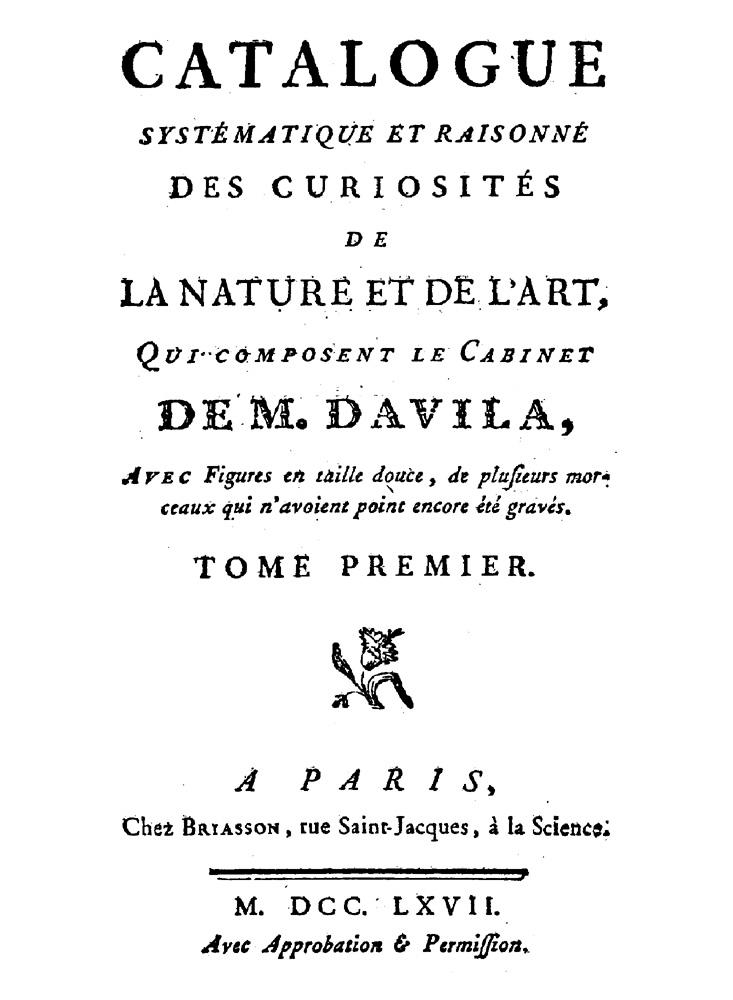DáVILA, Pedro Franco.
(1713? – 1785)
Born to wealth, Dávila moved in 1748 to Paris, where he lived most of his life. In 1769, he was appointed perpetual Inspector of the Royal Natural History Cabinet in Madrid.
Biographical references: ABE: I 260, 45-50; 349, 98. • Thomas, Dictionary of Biography, 1884: 728. • WBI. • Wilson, History of Mineral Collecting, 1994: 136-40 & 166.

1. French, 1767 [Sale catalog].
Catalogue | Systématique Et Raisonné | Des Curiosités | De | La Nature Et De L'Art, | Qui composent le Cabinet | De M. Davila, | Avec Figures en taille douce, de plusieurs mor- | ceaux qui n'avoient point encore été gravés. | Tome Premier [-Troisieme]. | [ornament] | A Paris, | Chez Briasson, rue Saint-Jacques, à la Science. | [double rule] | M. DCC. LXVII. | Avec Approbation & Permission.
3 vols. [Vol 1] 8°: a-b8 c2 A-Mm8 Nn6; 304l.; [i]-xxxvi, [1]-571, [1] p., 22 engraved plates; [Vol 2] 8°: a3 A-Ss8; 331l.; [i]-vj, [1]-656 p.; [Vol 3] 8°: π3 A-S8 T4 a-s8; 295l.; [i]-vj, [1]-290 p., 8 folding plates, [6], [1]-286, [2] p. Page size: 190 x 122 mm.
Contents: [Vol 1] [i-ii], Title page, verso "Le Présent Catalogue."; [iii]-vj, "Avertissement | De M. Davila."; [vii]-xxvj, "Préface."; [xxvii]-xxxv, "Table Synoptique | Du Premier Volume."; [1], "Approbation | De M. Adanson."; [1]-513, Text.; [514]-558, "Table | Alphabétique | Des Curiosités Naturelles."; [559]-[560], "Fautes | A corriger dans ce Volume."; [22 plates].; 561-571, "Explication Des Figures | Du Tome Premier."; [1 pg], Blank.
[Vol 2] [i-ii], Title page, verso "Le Présent Catalogue."; [iii]-vi, "Table Synoptique | Du Second Volume."; [1]-615, Text.; [616]-656, "Table | Alphabétique | Des Curiosités Naturelle | Contenues dans le Second Volume."
[Vol 3] [i-ii], Title page, verso "Le Présent Catalogue."; [iii]-vj, "Table Synoptique | Du Troisieme Volume."; [1]-258, Text.; [259]-286, "Table | Alphabétique | Des Petrifications | Contenues dans le troisieme Volume."; [8 folding plates].; 287-290, "Explication Des Figures | Du Tome Troisieme."; [1 pg], Sectional title page, "Catalogue | Raisonné | Des Curiosités | De L'Art."; [1 pg], Blank.; [4 pgs], "Table | Des Curiosités De L'Art."; [1]-266, Text.; [267-286, "Table | Alphabétique."; [1 pg], "Fautes."; [1 pg], Blank.
Very scarce. Pedro Francisco Dávila, possessor of the largest collection of natural history specimens in Paris, and wishing to establish an institution in Spain to preserve it, approached King Carlos III of Spain. But political difficulties and a approaching war with England distracted the king, who declined the purchase. Because of debts incurred building the collection, creditors forced Dávila to put the accumulation up for auction in Paris. For this purpose, a detailed collection catalog was required. Dávila had already written many descriptions, but it was his introduction through Balthasar Sage to the young Romé de l'Isle that created this remarkable record of the collection. Romé de l'Isle took the existing material, added considerably to the mineralogical descriptions, and put the catalog into publishable form. In this task he was assisted by Abbé Duguat who helped with the mineralogical descriptions and Abbé Gua de Malves [1712-1786] who described the shells. Through their efforts, two volumes describing natural history specimens were produced, one of which was entirely devoted to minerals. In addition, a third volume written by Romé de l'Isle probably with assistance from Pierre Remy, describes the fossils, artwork and books. The Dávila catalog (as it has become known) describes 8,096 mineral specimens that encompass a large range of localities, including a suite of specimens from Potosí in Spanish America. In addition, the catalog lists 5,253 shells, 600 preserved animals, 101 plants, 3,915 fossils, 154 bezoars and calculi, and 402 books. Over 12,000 prints and engravings, 1,741 original artworks, 441 maps, as well as various scientific instruments and precious stones are also described. Thus Dávila's collection was certainly one of the largest ever formed, and a major auction event of the 18th century.
The published catalog provides a detailed insight into his collection, his special tastes and preferences. The major value of the collection lay in its superb mineral specimens, many of which were finely crystallized examples. Romé de l'Isle fully described the many fine mineralogical specimens, which included examples of native silver from Norway, cassiterite from the Dutch East Indies, crocoite from Siberia, pyrite from Columbia, and calcite from Saxony, etc. Dávila had been a collector for over 20 years when his accumulation was auctioned. In that time, he or his agents had acquired specimens at other auctions, including those that liquidated the collections of Albertus Seba in 1752, the Abbé Joly de Fleury in 1755, Claude Geoffroy in 1753 and others. Dávila's catalog received wide distribution in Paris, London, Amsterdam, Rotterdam and Basle. This helped push the total realized by Dávila to over 800,000 Spanish reales, more than enough to pay of his creditors, and to finance a second collection, which he immediately began to build. Within two or three years he had again amassed a sizable collection, specializing in minerals, and selected with more knowledge and experience than his first collection had been. Once again he dreamed of establishing the cabinet in Madrid. In October 1771 this became reality when King Carlos III agreed to take over his collections, with Dávila serving as director for life. This enormous collection eventually passed into the National Museum of Natural Sciences in Madrid, where Dávila's specimens are still preserved today.
Bibliographical references: Berlinische Sammlungen: 9, 544-5. • BMC. • Dana's 7th (Bibliography): 69. • DSB: 11, 520-4. • Freilich Sale Catalog: no. 150. • Gatterer, Mineralogischen Literatur, 1798-9: 1, 272. • Göttingische gelehrte Anzeigen: 1767, 1244. • LKG: XV 20. • Metzger, Genèse de la Science des Cristaux, 1918. • Sinkankas, Gemology Bibliography, 1993: no. 1594. • Wilson, History of Mineral Collecting, 1994: 136-40, 166 & 209 [provides a detailed history of the collections].
.